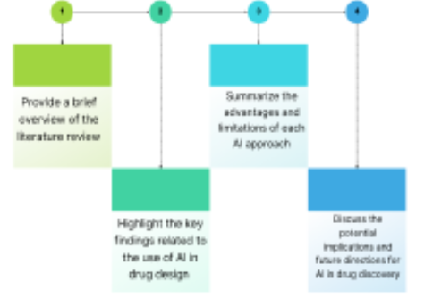


Journal of Pharmaceutical Research
DOI: 10.18579/jopcr/v22.3.23.54
Year: 2023, Volume: 22, Issue: 3, Pages: 103-112
Review Article
Varun Pareek1, Lakshya Tuteja2, Lokendra Sharma3, Susheel Kumar4,*, Noopur Verma5
1P G resident, Department of Pharmacology, RUHS-CMS, Jaipur, Rajasthan, India
2RUHS-CMS, Jaipur, Rajasthan, India
3HOD, Department of Pharmacology, RUHS-CMS, Jaipur, Rajasthan, India
4Assistant Professor, RUHS-CMS, Jaipur, Rajasthan, India
5Senior Resident, RUHS-CMS, Jaipur, Rajasthan, India
*Corresponding Author
Email: [email protected]
Introduction: Artificial intelligence (AI) has the potential to revolutionize drug design and discovery by significantly reducing the time and costs involved in developing new drugs. This literature review aims to explore the use of AI in drug design, focusing on virtual screening, de novo drug design, and prediction of ADME properties. Objective: The objective of this review is to provide an overview of the AI techniques used in drug design and their applications in virtual screening, de novo drug design, and prediction of ADME properties. The review also aims to summarize the advantages and limitations of these approaches and present case studies and examples showcasing their use in drug design. Methodology: A comprehensive search of academic databases was conducted, and 11 relevant articles were selected for inclusion in this review. The selected articles were analyzed to identify the AI techniques used in drug design, their applications, advantages, and limitations. Case studies and examples were also examined to demonstrate the efficacy of AI in drug design. Results: AI techniques such as machine learning, deep learning, and reinforcement learning have been successfully used in virtual screening, de novo drug design, and prediction of ADME properties. Virtual screening involves the use of AI algorithms to identify promising compounds for further testing, while de novo drug design involves the generation of novel compounds using AI techniques. Prediction of ADME properties involves the use of AI to predict the absorption, distribution, metabolism, and excretion of drug candidates. The case studies and examples presented in this review demonstrate the potential of AI to accelerate drug design and discovery. Conclusion: AI has the potential to revolutionize drug design and discovery by significantly reducing the time and costs involved in developing new drugs. Virtual screening, de novo drug design, and prediction of ADME properties are among the most promising applications of AI in drug design. However, further research is needed to fully explore the potential of AI in drug design and overcome some of the limitations of current approaches.
Keywords: Artificial Intelligence; Drug Design; Virtual Screening; De Novo Drug Design; ADME Prediction
© 2023 Published by Krupanidhi College of Pharmacy. This is an open-access article under the CC BY-NC-ND license (https://creativecommons.org/licenses/by-nc-nd/4.0/)
Subscribe now for latest articles and news.